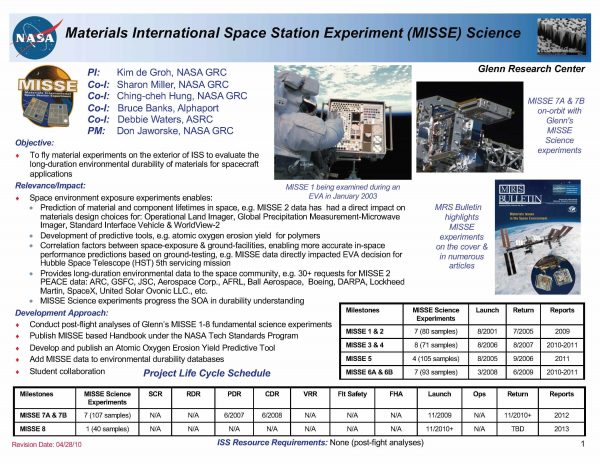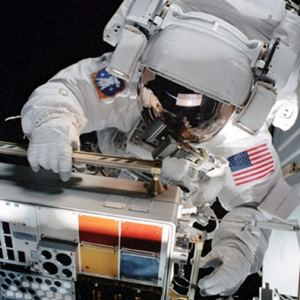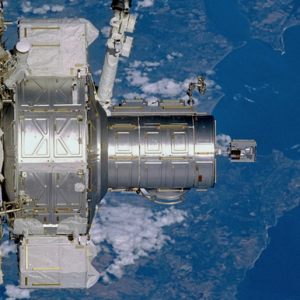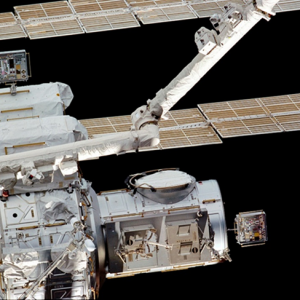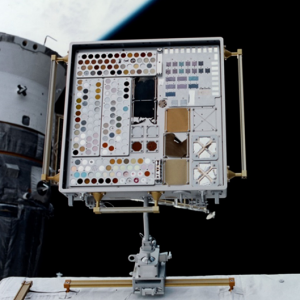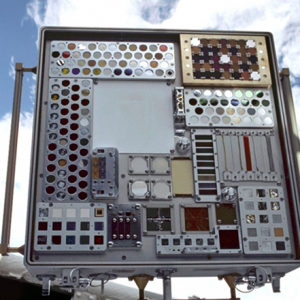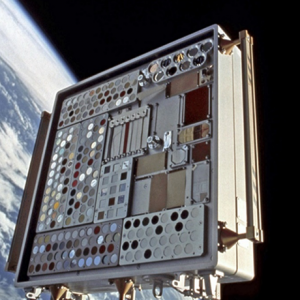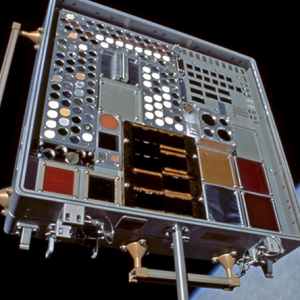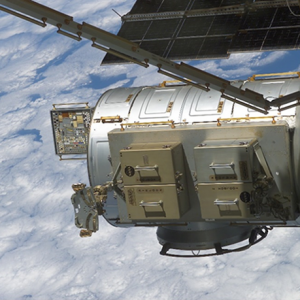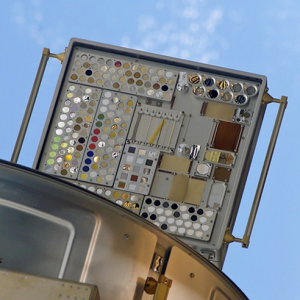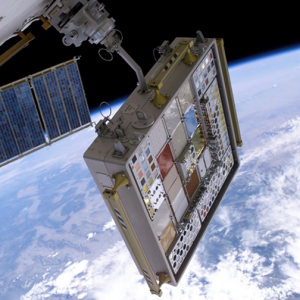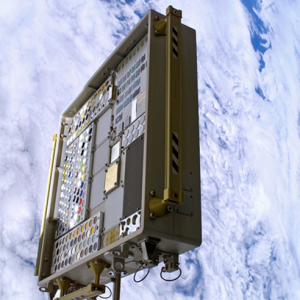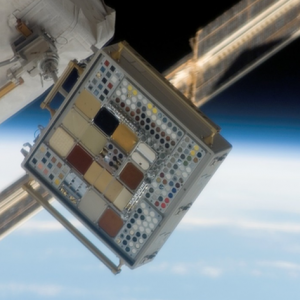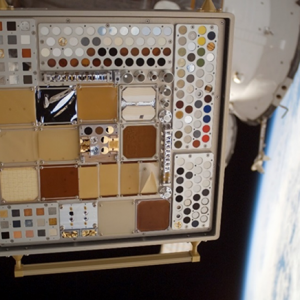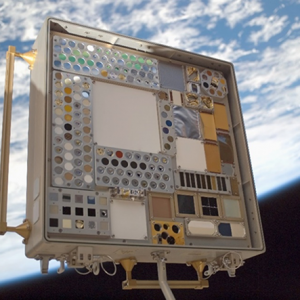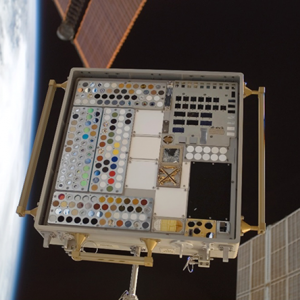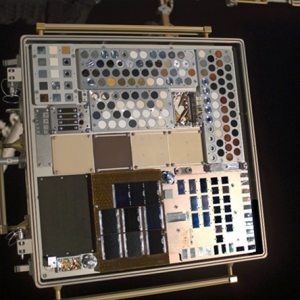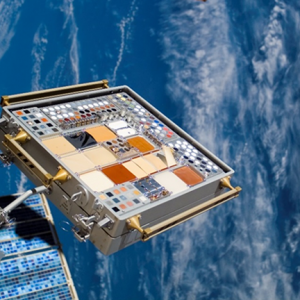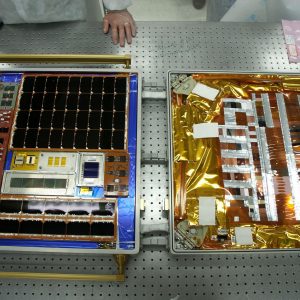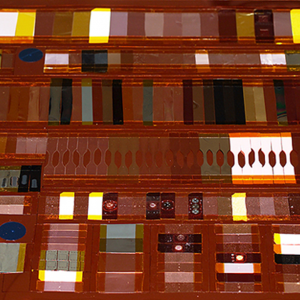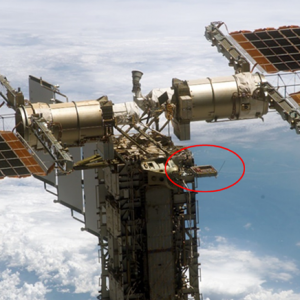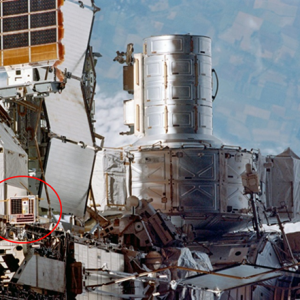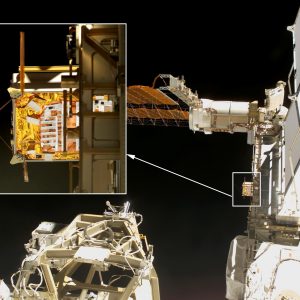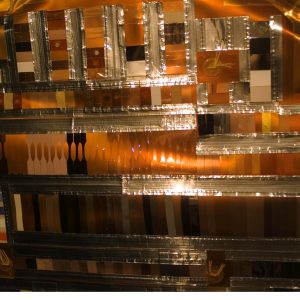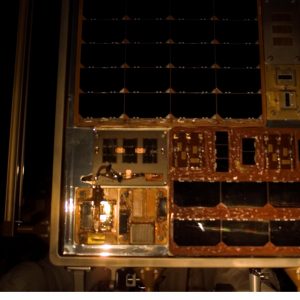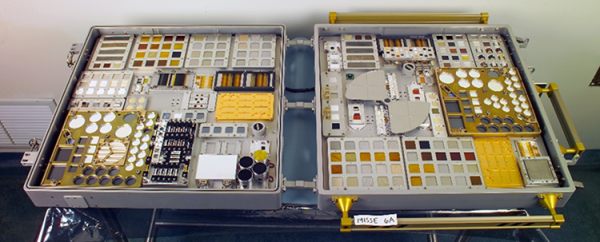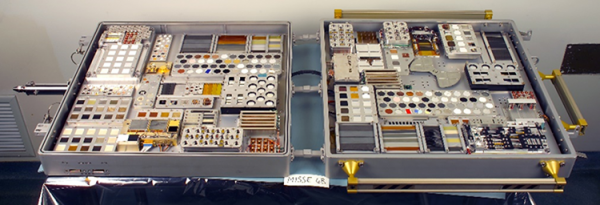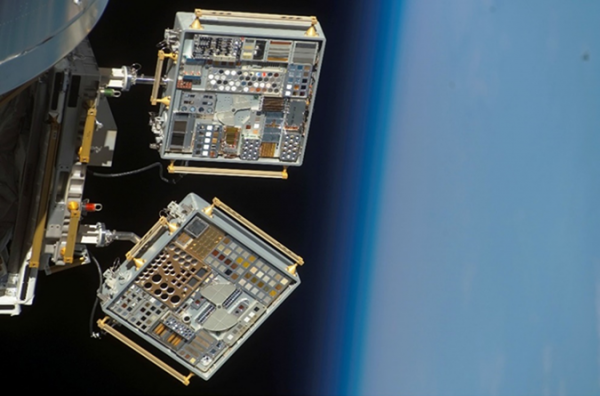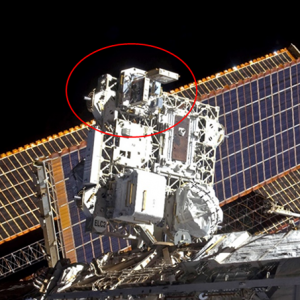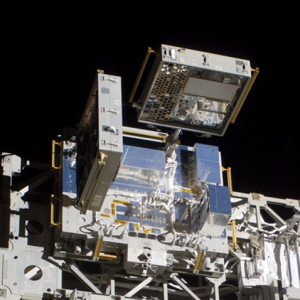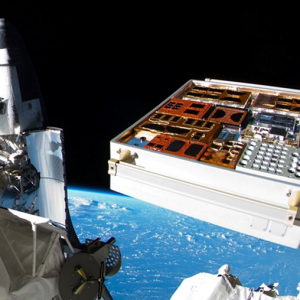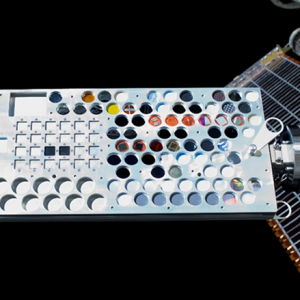MISSE
The Materials International Space Station Experiment (MISSE) project involves a series of spaceflight missions with experiments flown on the exterior of the ISS to test the performance and durability of materials and devices exposed to the LEO space environment.
Materials International Space Station Experiment (MISSE)
Since 2001, the Materials International Space Station Experiment (MISSE) series has tested some 4,000 material samples and specimens — from lubricants and paints to fabrics, container seals and solar cell technologies — to demonstrate their durability in the punishing space environment.
Flown 220 miles above Earth, fixed to the exterior of the International Space Station for periods of up to four years, these innovative experiments endured extreme levels of solar and charged-particle radiation, atomic oxygen, hard vacuum, temperature extremes and contamination, giving researchers unprecedented insight into developing durable materials for spacecraft, flight hardware and even astronaut clothing.
Because such research is difficult to simulate effectively in Earth-based laboratories, the MISSE series is providing NASA and the space community with crucial insight into the challenges of protecting astronaut health and establishing a permanent human presence in space.
Introduction
Materials International Space Station Experiment (MISSE)
The Materials International Space Station Experiment (MISSE) project involves a series of spaceflight missions with experiments flown on the exterior of the ISS to test the performance and durability of materials and devices exposed to the LEO space environment. In the MISSE 1–8 missions, individual flight experiments were flown in suitcase-like containers called Passive Experiment Containers (PECs) that provided exposure to the space environment from 2001 until 2013. The PECs were placed outside the ISS in various locations by an astronaut during an extravehicular activity (EVA), or spacewalk. The PECs were positioned in either a ram/wake or a zenith/nadir orientation, and exposed for 1-4 years.[de Groh 2008, de Groh 2019] MISSE evolved significantly during the MISSE 1-8 missions. While MISSE 1–4 contained primarily “passive” experiments, MISSE 5 included “active” experiments that were battery powered and included telemetry to the ground via radio.[de Groh 2011] MISSE 6 and 7 were both expanded to accommodate a growing number of organizations that wanted to fly new experiments, and both contained active experiments powered directly from the ISS.[de Groh 2011] After the mission exposure, the PECs were retrieved during an EVA, and returned on the shuttle for post-flight analyses. In the post-Shuttle Era, MISSE missions (MISSE-9 and higher) are now being flown on the MISSE-Flight Facility (MISSE-FF), ISS’s permanent external material science platform.
References:
- de Groh, K. K., Banks, B. A., Dever, J. A., Jaworske, K. J., Miller, S. K., Sechkar, E. A. and Panko, S. R., “NASA Glenn Research Center’s Materials International Space Station Experiments (MISSE 1-7),” Proceedings of the International Sym. on “SM/MPAC&SEED Experiment,” JAXA-SP-08-015E, 2009, pp. 91–119; also NASA TM-2008-215482, Dec. 2008.
- de Groh, K. K., Jaworske, D. A., Kinard, W. H., Pippin, H. G., Jenkins, P. P, “Tough Enough for Space: Testing Spacecraft Materials on the ISS,” Technology Innovation, Vol. 15, No. 4, 2011, pp.50-53.
- de Groh, K. K. and Banks, B. A., “Atomic Oxygen Erosion Data from the MISSE 2-8 Missions,” NASA TM-2019-219982, May 2019.
MISSE-X
MISSE-X was a NASA Technology Demonstration Mission project led by NASA’s Langley Research Center in collaboration with NASA Glenn Research Center. The goal was development of a permanent MISSE testing platform outside ISS. The MISSE-X concept included new enhancements, such as near real-time experiment monitoring, daily photographing of samples in flight and expanded accommodations to house more, and more complex, experiments. The MISSE-X team also developed plug-and-play mechanical and avionics systems to enable the cost-effective and timely replacement of completed experiments. The concept also included new models to correlate ground- and space-based data, and to compare results in low-Earth orbit with anticipated results in other space environments.
MISSE-X was designed to be robotically mounted and serviced on the station’s exterior. Individual experiments could be placed in modular experiment containers, which would be installed in larger, portable experiment containers. The concept accommodated both active experiments — those receiving space station power and data collection — and passive experiments. The modular containers could be removed and replaced with other experiments after various periods of space exposure, from six months to three years. Passive experiments and active experiments could be returned to Earth, where scientists could analyze the materials and devices to see how they fared. The MISSE-X project was transferred in 2012 from the Technology Demonstration Missions Program to the International Space Station Program, where it evolved into the current MISSE-Flight Facility project.
https://www.nasa.gov/mission_pages/tdm/missex/index.html
Materials International Space Station Experiment-Flight Facility (MISSE-FF)
The MISSE-FF is operated by Alpha Space Test & Research Alliance, LLC.[Alpha Space 2021] It is a modular and robotically serviceable external facility that is located on ISS Express Logistics Carrier-2 Site 3 (ELC-2 Site 3). It provides ram, wake, zenith, and nadir exposures. The MISSE-FF supports both passive and active experiments, with downlink of data. It is designed to include active environmental sensors that provide environmental data over time in each flight orientation, including temperature, contamination and solar exposure (ultraviolet (UV) radiation). Arrangements can be made for sensors to be flown to provide atomic oxygen fluence and total ionizing dose data. On-orbit facility cameras are typically scheduled to provide monthly sample images.[de Groh 2021]
MISSE Sample Carriers (MSCs), also called MISSE Science Carriers, house the material flight experiments. Each MSC has two sides, a mount-side (MS) and a swing-side (SS), with a central hinge. Materials and spacecraft components can be flown on either the MS or SS decks for direct space exposure, or they can be mounted on the underdecks. The MSCs are launched closed as pressurized cargo on either the Northrup Grumman Cygnus or SpaceX Dragon spacecraft, moved outside the ISS through the Kibo Japanese Experiment Module (JEM) Airlock on the MISSE Transfer Tray (MTT), then installed on the MISSE-FF structure via robotic arm. The SS decks are remotely opened to expose the experiments to space. The MSCs are closed during resupply ship dockings to prevent contamination and minimize atomic oxygen exposure of wake surfaces. The MSCs are typically closed during local EVAs and for on-demand images. [de Groh 2021]
The MISSE-FF and the inaugural set of experiments, called MISSE-9, were launched aboard the SpaceX Commercial Resupply Services-14 (CRS-14) Dragon, also called SpaceX-14, on April 2, 2018. The MISSE-FF was robotically installed on ELC-2 Site 3 on April 8, 2018. The MISSE-9 PCE-1 experiments were deployed (MSCs opened to space for the first time) on April 19, 2018 with the PCE-1 MSCs scheduled for a 1-year space exposure mission.
References:
- Alpha Space website (2021), https://www.alphaspace.com/index.html
- de Groh, K. K. and Banks, B. A., “MISSE-Flight Facility Polymers and Composites Experiment 1-4 (PCE 1-4),” NASA TM-20205008863 (February 2021). (https://ntrs.nasa.gov/citations/20205008863)
MISSE 1-8 Missions
MISSE-1 and MISSE-2
The Materials International Space Station Experiment-1 and -2 (MISSE-1 and MISSE-2) were launched on the STS-105 shuttle mission and deployed in ram/wake flight orientations on August 16, 2001 on the High Pressure Gas Tank (HPGT) and Quest Airlock, respectively. They were planned for a one-year exposure. Due to the delays incurred following the Columbia accident, they were not retrieved until the STS-114 Return to Flight mission four years later. Thus, they were retrieved on July 30, 2005 after 3.95 years of space exposure and returned on STS-114.
MISSE-1 and 2 were test beds for materials and coatings attached to the outside of the ISS to evaluate the effects of atomic oxygen, direct sunlight, and extremes of heat and cold. This experiment allows the development and testing of new materials to better withstand the rigors of space environments. Results will provide a better understanding of the durability of various materials when they are exposed to the space environment. Many of the materials may have applications in the design of future spacecraft.
Researchers from the private and public sector prepared a wide range of samples for the first externally mounted experiment on ISS. MISSE-1 and -2 were testbeds for more than 400 materials and coatings samples, testing their survivability under the corrosive effects of the space environment; including micrometeoroid and orbital debris strikes, atomic oxygen attack, intense ultraviolet radiation from the sun, and extreme temperature swings. Result provide a better understanding of the durability of various materials in this environment. Many of the materials may have applications in the design of future spacecraft.
MISSE-1 and MISSE-2 Gallery
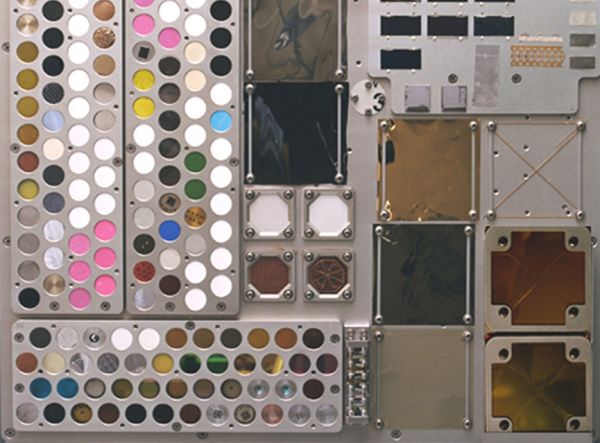 |
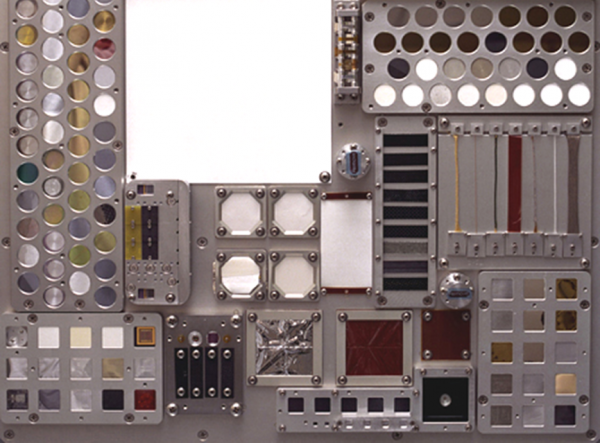 |
| a. | b. |
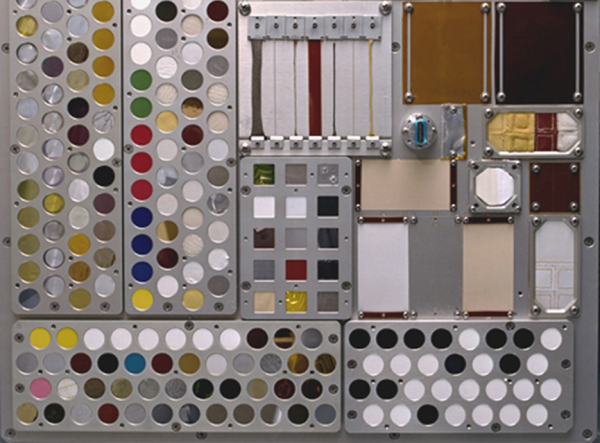 |
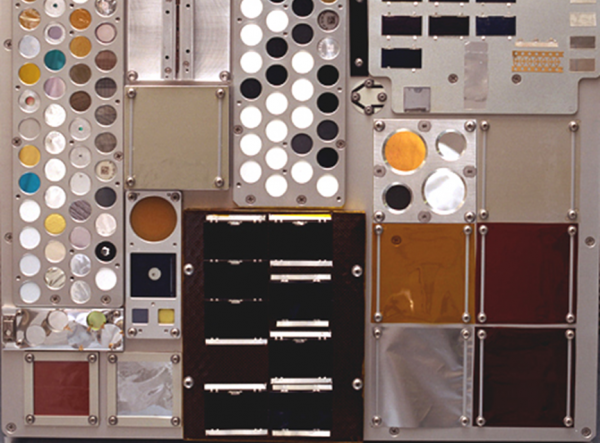 |
| c. | d. |
NASA Langley Research Center Images – Pre-flight photographs of the MISSE 1 and MISSE 2 decks: a). MISSE 1 Tray 1 deck, b), MISSE 1 Tray 2 deck, c). MISSE 2 Tray 1 deck, and d). MISSE 2 Tray 2 deck.
MISSE-3 and MISSE-4
The Materials International Space Station Experiment-3 and -4 (MISSE-3 and MISSE-4) were launched on STS-121 and deployed in ram/wake flight orientations on August 3, 2006 on the High Pressure Gas Tank (HPGT) and Quest Airlock, respectively. They were retrieved on August 18, 2007 after 1.04 years of space exposure and returned as part of the STS-118 mission. MISSE-3 and MISSE-4 contained approximately 875 specimens of various materials.
The specimens include a variety of materials such as paint and protective coatings that will be used on future spacecraft such as satellites. Environmental monitors recorded the thermal cycling (the change in temperature) that the experiment was subjected to while on orbit. New material that might be used in the next generation of EVA (extravehicular activity) suits was tested to examine how the material reacts to the harsh space environment.
As part of an education outreach program, three million basil seeds were placed in containers located underneath the sample trays on MISSE 3 and 4 PECs. These seeds were returned to Earth as part of the STS-118/13A.1 mission in which Astronaut Barbara Morgan initiated the grown cycle of basil seeds inside the ISS, The seeds were sent to school children for them to plant and observe the differences between seeds exposed to space and seeds that have remained on Earth.
MISSE-3 and MISSE-4 Gallery
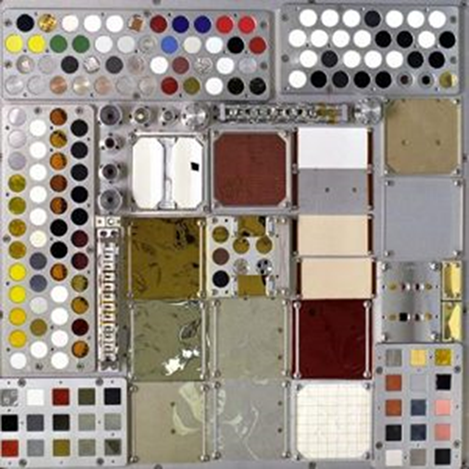 |
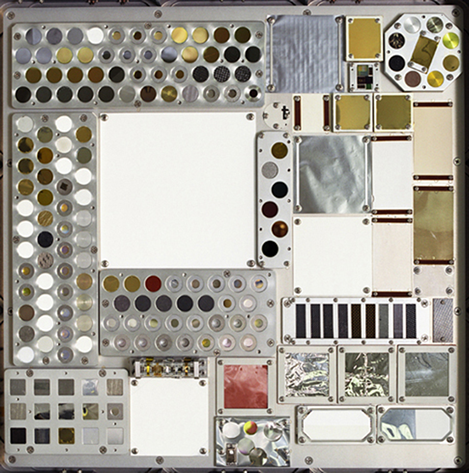 |
| a. | b. |
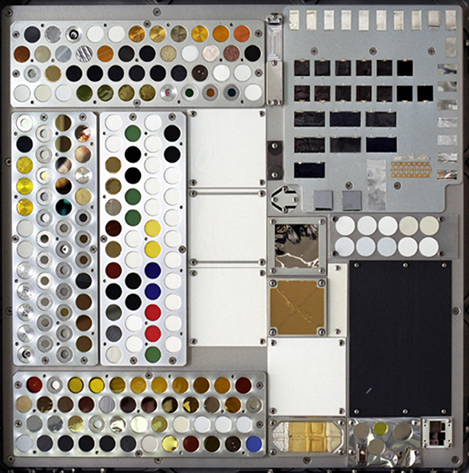 |
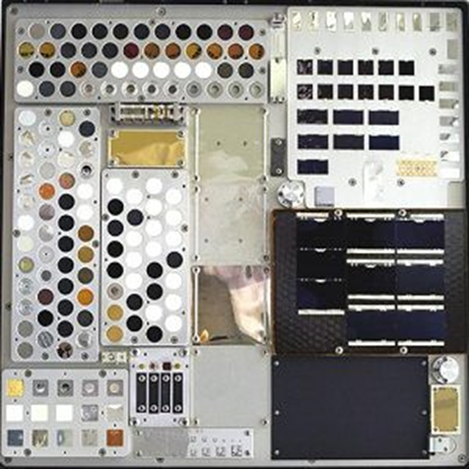 |
| c. | d. |
NASA Langley Research Center Images – Pre-flight photographs of the MISSE 3 (PEC 3) and MISSE 4 (PEC 4) : a). NASA Image: 2002-L-02093 – MISSE 3 Tray 1 deck, b), NASA Image: 2002-L-01725 – MISSE 3 Tray 2 deck, c). NASA Image: 2002-L-02076– MISSE 4 Tray 1 deck, and d). NASA Image: 2002-L-02093 – MISSE 4 Tray 2 deck.
MISSE-5
The Materials International Space Station Experiment-5 (MISSE-5) was launched on STS-114 and deployed on August 3, 2005 in a zenith/nadir flight orientation on the Aft P6 Trunion Pin Handrail. The single PEC was retrieved on September 15, 2006 after 1.12 years of space exposure and returned as part of the STS-115 mission.
MISSE-5 was a collaboration between NASA Langley Research Center, Glenn Research Center, Ohio State University, Naval Research Laboratory and U.S. Naval Academy and consisted of three experiments: PCSat-2, Forward Technology Solar Cell Experiment (FTSCE) and the Thin Films Materials Experiment.
The Prototype Communications Satellite-2 (PCSat-2) was a communication system sponsored by the United States Naval Academy. PCSat-2 had two objectives: (1) to test the Amateur Satellite Service off-the-shelf solution for telemetry command and control; (2) to provide a communication system for the Forward Technology Solar Cell Experiment (FTSCE). PCSat-2 was able to transmit solar cell data for FTCSE using the Amateur Radio Satellite Service with a 145.825 uplink and 435.275 +/- 10 KHz Doppler downlink.
The Forward Technology Solar Cell Experiment (FTSCE), flown in the zenith flight direction, characterized the durability and the electrical output of 39 advanced solar cell samples that could be used on future space exploration vehicles. Several types of solar cell technologies were tested: triple junction InGaP/GaAS/Ge; thin film amorphous Si and Culn(Ga)Se2; and single junction GaAs cells. It is known that solar cells degrade over time when exposed to the space environment. FTSCE used their onboard instrumentation to measure the performance and downlink the data to Earth through the PCSat-2.
The Thin Film Materials Experiment consists of 254 thin film samples that were attached to the thermal blanket protecting the PCSAT2 hardware. The samples are exposed directly to the nadir space environment in order to evaluate the degradation of the materials over time. These materials range from testing polymer coatings to solar array blanket material to paints that are used on spacecraft and many others. An additional aspect of the Thin Film Materials experiment is the educational component. Of the 254 samples, 49 of them are part of a collaboration between the Glenn Research Center and the Hathaway Brown School in Cleveland, OH.
The technology testing that occurred during the MISSE-5 investigation provided necessary data to develop new space exploration vehicles, satellites and communication systems that will take us to the Moon, Mars and beyond.
MISSE-5 Gallery
MISSE-6A and 6B
The Materials International Space Station Experiment-6A and -6B (MISSE-6A and MISSE-6B) were launched on the STS-123 shuttle mission and deployed in ram/wake flight orientations on March 22, 2008 on the Columbus Laboratory. They were retrieved on September 1, 2009 after 1.12 years of space exposure and returned on STS-128.
The samples for MISSE-6A and 6B included over 400 new and affordable materials that may be used in advanced reusable launch systems and advanced spacecraft systems including optics, sensors, electronics, power, coatings, structural materials and protection for the next generation of spacecraft. The development of new generations of materials and material technologies is essential to the mission of traveling beyond Earth’s orbit.
MISSE-7A and -7B
The Materials International Space Station Experiment-7A and -7B (MISSE-7A and MISSE-7B) were launched on STS-129 and deployed in zenith/nadir and ram/wake flight orientations, respectively, on the EXPRESS Logistics Carrier 2 (ELC 2) Site 3 on November 23, 2009. They were retrieved on May 20, 2011 after 1.49 years of space exposure and returned as part of the STS-134 mission.
The MISSE-7 mission includes a suite of experiments that include over 700 new and affordable materials. The samples tested have potential use in advanced reusable launch systems and advanced spacecraft systems including solar cells, optics, sensors, electronics, power, coatings, structural materials and protection for the next generation of spacecraft. The development of the next generation of materials and material technologies is essential to the mission of traveling beyond Earth’s orbit. MISSE-7 was the first PEC to receive power directly from the ISS and use the ISS communication system uplink/downlink capabilities to receive commands downlink data.
Included in the MISSE-7 experiment suite is the Forward Technology Solar Cell Experiment II (FTSCE II). The FTSCE II is designed to measure solar cell I-V curves under Air Mass Zero (AMO) conditions on board the ISS. The FTSCE II characterizes 36 cells with I-V curves and four cells with short circuit current measurements. Twelve temperature sensors and a two-axis sun sensor monitor the environment. The test cells include current and next generation triple-junction production cells from Emcore and Spectrolab as well as advanced inverted metamorphic (IMM) and other thin film III-V cells from Emcore, Spectrolab and MicroLink Devices, Inc. There are also over 61 passive samples.
MISSE-7A and MISSE-7B Gallery
MISSE-8 and ORMatE-III R/W
The Materials on International Space Station Experiment – 8 (MISSE-8) mission consisted of the MISSE 8 PEC and a smaller passive tray called the Optical Reflector Materials Experiment III R/W (ORMatE-III R/W). The MISSE 8 PEC was attached to ELC 2 in a zenith/nadir orientation during an EVA as part of the STS-134 Shuttle mission on May 20, 2011. Because of concerns of outgas contamination from the neighboring Alpha Magnetic Spectrometer (AMS) payload, ORMatE-III R/W was deployed in a ram/wake orientation during the STS-135 Shuttle mission on July 12, 2011, approximately two months after deploy of the MISSE 8 PEC. Once positioned on ELC 2, the PEC and ORMatE-III remained exposed to the LEO space until they were retrieved on July 9, 2013 after 2.14 and 2.00 years of space exposure, respectively, and returned to Earth in the SpaceX-3 Dragon.
The MISSE-8 is a suite of experiments that includes new and affordable materials and computing elements. The samples tested have potential use in advanced reusable launch systems and advanced spacecraft systems including solar cells, optics, sensors, electronics, power, coatings, structural materials and protection for the next generation of spacecraft. The development of the next generation of materials and computing technologies is essential to the mission of traveling beyond Earth’s orbit. One MISSE 8 experiment is the Flight Support Equipment – SpaceCube (MISSE-8 FSE) which tested the radiation tolerance of a computer made to work in space.
MISSE-8 is the third experiment in the MISSE program to receive power directly from the ISS, and the second to use uplink/downlink capabilities on the ISS communication system to receive commands and downlink data.
MISSE-8 and ORMatE-III R/W Gallery
MISSE-Flight Facility (MISSE-FF) Missions
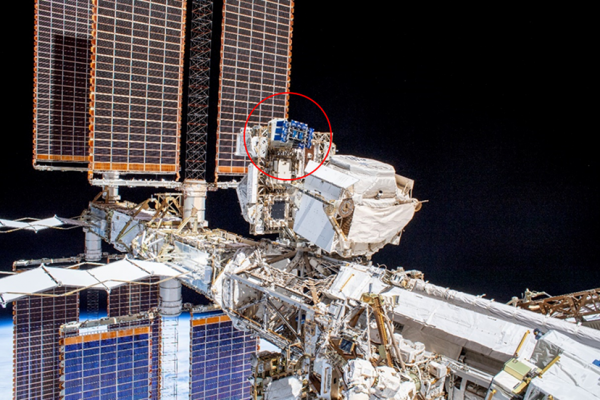
MISSE-9
The MISSE-FF and the inaugural set of experiments, called Materials International Space Station Experiment-9 (MISSE-9), were launched aboard the SpaceX-14 Dragon on April 2, 2018. The MISSE-9 MSCs were installed in the MISSE-FF on April 18-19, 2018 and deployed (opened to space) on April 19, 2018. The majority of the MISSE-9 MSCs were returned to Earth in the SpaceX-17 Dragon capsule with splash-down on June 3, 2019.
The MISSE-9 mission includes a suite of six NASA experiments. The samples include three dimensional printed materials, sensors, sensor components, textiles, carbon fiber laminates, paints, coatings, polymers, and composites. Ten sample decks (5 MSCs) were deployed as part of the MISSE-9 mission, with a total of 229 individual samples.
MISSE-9 Polymers and Composites Experiment (MISSE-9)
NASA Glenn’s MISSE-9 Polymers and Composites Experiment (PCE or PCE-1) is a passive investigation with 138 samples that were flown in ram (39 samples), wake (52 samples) and zenith (47 samples) orientations. These flight orientations provide different environmental exposures, such as significantly different levels of atomic oxygen. Polymers and other oxidizable materials can be eroded away due to reaction with atomic oxygen. Therefore, to design durable spacecraft it is important to understand the rate of erosion. This can be achieved by knowing the atomic oxygen erosion yield (Ey), volume loss per incident oxygen atom, of spacecraft materials.[de Groh 2021]
The primary objective of the PCE-1 is to determine the LEO atomic oxygen (Ey) of spacecraft polymers, composites, and coated samples as a function of solar irradiation and atomic oxygen fluence. Additional experiment objectives include: 1) Characterization of optical and tensile property degradation of polymers and composites in LEO, 2) Improve the understanding of atomic oxygen scattering mechanisms for atomic oxygen undercutting and erosion predictive models, and 3) Determine the functionality and durability of LEO exposed cosmic ray shielding and shape memory composite samples. Samples were also flown to determine the mission atomic oxygen fluence and on-orbit molecular contamination in the MISSE-9 ram, wake and zenith orientations. The PCE provides important space environmental durability data for Earth and Mars orbiting spacecraft.[de Groh 2021]
MISSE-10
The Materials International Space Station Experiment-10 (MISSE-10) experiment MSCs were launched aboard the Northrop Grumman (NG) Cygnus cargo ship (NG-10) on November 17, 2018. The MSCs were installed in the MISSE-FF in January 2019 and deployed April 26, 2019. The majority of the MISSE-9 MSCs were returned to Earth in the SpaceX-20 Dragon capsule with splash-down on April 7, 2020. The MISSE-10 ram R1 carrier (MSC 11) was returned in the SpaceX-21 Dragon capsule with on January 13, 2021 EST (January 14, 2021 UTC).
The Materials International Space Station Experiment-10 (MISSE-10-NASA) mission includes eight NASA experiments. The experiment samples are mounted to the MSCs decks that are installed in each half of a MISSE Sample Carrier (MSC). Fourteen sample decks deploy as part of the MISSE-10 mission, with a total of 188 individual NASA and commercial samples.
MISSE-10 Polymers and Composites Experiment-2 (PCE-2)
NASA Glenn’s MISSE-10 Polymers and Composites Experiment-2 (PCE-2) is a passive experiment with 43 samples being flown in ram (21 samples), zenith (10 samples), and nadir (12 samples) directions. The objectives of the PCE-2 are similar to Glenn’s MISSE-9 PCE-1. The primary objective is to determine the low earth orbit (LEO) atomic oxygen erosion yield (Ey) of polymers, composites, and coated samples as a function of solar irradiation and atomic oxygen fluence. Polymers and other oxidizable materials may be eroded away due to reaction with atomic oxygen. Therefore, to design durable spacecraft it is important to understand the rate of erosion. This is achieved by knowing the atomic oxygen Ey, volume loss per incident oxygen atom, of spacecraft materials. Additional PCE-2 experiment objectives include: 1) Characterization of optical property degradation of spacecraft polymers and composites in LEO, 2) Improve the understanding of atomic oxygen scattering mechanisms for atomic oxygen undercutting and erosion predictive models, and 3) Determine the functionality and durability of LEO exposed cosmic ray shielding and shape memory composite samples. Also like the MISSE-9 PCE-1, samples were flown to determine the atomic oxygen fluence for the mission, including a unique photographic atomic oxygen fluence monitor, and characterize any molecular contamination, in each flight direction.[de Groh 2021]
MISSE-11
The Materials International Space Station Experiment- 11 (MISSE-11) experiment MSCs were launched aboard NG-11 on April 17, 2019. The MSCs were installed in the MISSE-FF on April 26, 2019 and deployed shortly afterwards. The MISSE-11 ram and zenith MSCs were returned in the SpaceX-20 Dragon capsule on April 7, 2020. The MISSE-11 wake MSC was returned in the SpaceX-21 Dragon capsule with on January 13, 2021 EST (January 14, 2021 UTC).
The Materials International Space Station Experiment-11 (MISSE-11) includes a suite of NASA experiments. Six sample decks (three MSCs) were deployed as part of the MISSE-11 mission, with a total of 99 individual samples. This addition increased the total of MISSE samples on orbit to 349 as MISSE-11 joined MISSE-10 and elements of MISSE-9.
MISSE-12
The Materials International Space Station Experiment-12 (MISSE-12) experiment MSCs were launched to ISS aboard NG-12 on November 2, 2019. The MISSE-12 MSCs were installed in the MISSE-FF on November 11, 2019. The MSCs were deployed in either December 2019 or March 2020. The MISSE-12 MSCs were returned as part of the SpaceX-21 mission with splashdown on January 13, 2021 EST (January 14, 2021 UTC).
MISSE-12 Polymers and Composites Experiment-3 (PCE-3)
NASA Glenn’s MISSE-12 Polymers and Composites Experiment-3 (PCE-3) is a passive experiment with 86 samples that were flown in ram (30 samples), wake (42 samples) and zenith (14 samples) directions. The primary objective is to determine the LEO AO Ey of polymers, composites, and coated samples as a function of solar irradiation and AO fluence. Like, the PCE-1 and PCE-2, samples are included to determine the AO fluence for the mission, and characterize any molecular contamination, in each flight direction. Additional experiment objectives include: 1) Characterization of optical and tensile property degradation of spacecraft polymers and composites in LEO, 2) Understanding of AO undercutting mechanisms for improved AO erosion modeling, and 3) Determining the functionality and durability of shape memory alloys, shape memory composites, melanin based composites and new solar cell cover slides after space radiation exposure.[de Groh 2021]
MISSE-13
The Materials International Space Station Experiment-13 (MISSE-13) experiment MSC’s were to ISS aboard SpaceX-20 on March 6, 2020. The MISSE-13 MSCs were installed in the MISSE-FF on March 18, 2020 and deployed on March 20, 2020. The MISSE-13 MSCs were returned as part of the SpaceX-21 mission with splashdown on January 13, 2021 EST (January 14, 2021 UTC).
The Materials International Space Station Experiment-13-NASA (MISSE-13-NASA) continues a series of investigations examining how the harsh environment of space affects new materials and material configurations needed for specific space missions. It includes investigations into the performance and durability in space of polymers, composites, thermal protection systems, photovoltaic technologies and radiation shielding materials. MISSE experiments incorporate lessons learned from previous missions and fly similar materials on multiple missions to determine erosion and degradation trends and help forecast durability.
MISSE-13 Polymers and Composites Experiment-4 (PCE-4)
NASA Glenn’s MISSE-13 Polymers and Composites Experiment -4 (PCE-4) is a passive experiment with 98 samples being flown in the wake (65 samples) and zenith (33 samples) directions. The primary objectives of the PCE-4 are to determine optical and mechanical property degradation of spacecraft materials, and to assess the functionality of shape memory alloys, shape memory polymer composites, melanin based composites and elastomer seal samples after radiation exposure in LEO. Like, the PCE 1-3, samples are included to determine the AO fluence in each mission orientation. Teflon FEP samples will be used for contamination studies. Specific materials and sample objectives are discussed in the PCE-4 Flight Sample section below.[de Groh 2021]
MISSE-FF Mission Reference:
- de Groh 2021: de Groh, K. K. and Banks, B. A., “MISSE-Flight Facility Polymers and Composites Experiment 1-4 (PCE 1-4),” NASA TM-20205008863 (Feb. 2021). https://ntrs.nasa.gov/citations/20205008863
PCE 1-4 Contact Information:
Kim de Groh, NASA GRC
Contact Information
PI: Kim de Groh, NASA GRC
Co-I: Sharon Miller, NASA GRC
Co-I: Ching-cheh Hung, NASA GRC
Co-I: Bruce Banks, Alphaport
Co-I: Debbie Waters, ASRC
PM: Don Jaworske, NASA GRC


